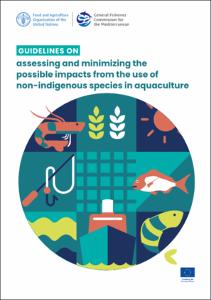| dc.coverage.spatial | Mediterranean Sea | en_US |
| dc.coverage.spatial | Black Sea | en_US |
| dc.date.accessioned | 2023-05-19T18:39:44Z | |
| dc.date.available | 2023-05-19T18:39:44Z | |
| dc.date.issued | 2023 | |
| dc.identifier.citation | FAO (2023) Guidelines on assessing and minimizing the possible impacts from the use of non-indigenous species in aquaculture. Rome, Italy, General Fisheries Commission for the Mediterranean, 32pp. DOI: https://doi.org/10.4060/cc3207en | en_US |
| dc.identifier.uri | https://repository.oceanbestpractices.org/handle/11329/2220 | |
| dc.description.abstract | Mediterranean and Black Sea aquaculture is a fast-growing sector that is becoming crucial for food security, employment opportunities and economic growth. To maintain this level of development and to enhance these important benefits, the sector tends to rely on non-indigenous species to diversify the range of species being farmed, adapt to climate change and open up new markets. However, the use of non-indigenous species can also have adverse impacts on biodiversity, natural habitats, ecosystems and related ecosystem services if not managed safely. Countries bordering the Mediterranean and the Black Sea share common aquatic ecosystems and, as a result, any local-scale environmental impacts could have wider impacts. While various aquaculture development plans and strategies exist within the GFCM area of application, the shared ecosystems within the region and the resulting risk of wider impacts underline the need for a common regional framework on aquaculture practices related to the use of non-indigenous species. Recognizing this need, the General Fisheries Commission (GFCM) of the Food and Agriculture Organization of the United Nations (FAO) included the preparation of guidelines on non-indigenous species in the 2018–2020 work programme for its Scientific Advisory Committee on Aquaculture (CAQ) and adopted them in 2021. They are consistent with global experiences and existing supranational and international instruments regarding the use of non-indigenous species in aquaculture, including the GFCM Strategy for the sustainable development of Mediterranean and Black Sea aquaculture.
The main purpose of these guidelines is to provide guiding principles and minimum common criteria to: i) help assess, prevent and minimize the risk of adverse impacts on biodiversity, natural habitats, ecosystems and related ecosystem services associated with the use of non-indigenous species; and ii) promote the development and sharing of a comprehensive knowledge base to address the challenges posed by the use of non-indigenous species. Following an introduction on the background and scope of the guidelines, this document highlights that national regulatory frameworks dedicated to aquaculture should include provisions addressing the introduction of non-indigenous species: the competent authority in each country should draw up and regularly monitor a list of species used in aquaculture and classify them as either “non-indigenous species” or “species that are already present” and countries should establish a minimum standard capacity prior to any introduction of non-indigenous species. Furthermore, it details the application process for an authorization to introduce non-indigenous species and emphasizes that applications should be examined by the competent national authority. Finally, it identifies the necessary conditions that should be fulfilled to minimize the risks of adverse impacts following the introduction of non-indigenous species, including border measures, quarantine and monitoring, as well as surveillance systems. | en_US |
| dc.language.iso | en | en_US |
| dc.publisher | General Fisheries Commission for the Mediterranean | en_US |
| dc.rights | Attribution-NonCommercial-ShareAlike 3.0 IGO | * |
| dc.rights.uri | http://creativecommons.org/licenses/by-nc-sa/3.0/ | * |
| dc.subject.other | Aquaculture | en_US |
| dc.subject.other | Non-indigenous species | en_US |
| dc.subject.other | Biodiversity | en_US |
| dc.subject.other | Marine biodiversity assessment | en_US |
| dc.subject.other | Risk assessment | |
| dc.subject.other | Introduced species | |
| dc.subject.other | Biosecurity | |
| dc.subject.other | Environmental regime | |
| dc.title | Guidelines on assessing and minimizing the possible impacts from the use of non-indigenous species in aquaculture. | en_US |
| dc.type | Report | en_US |
| dc.description.status | Published | en_US |
| dc.format.pages | 32pp. | en_US |
| dc.contributor.corpauthor | Food and Agriculture Organization of the United Nations (FAO) | en_US |
| dc.description.refereed | Refereed | en_US |
| dc.publisher.place | Rome, Italy | en_US |
| dc.identifier.doi | https://doi.org/10.4060/cc3207en | |
| dc.subject.parameterDiscipline | Fisheries and aquaculture | en_US |
| dc.description.currentstatus | Current | en_US |
| dc.description.sdg | 2.4 | en_US |
| dc.description.maturitylevel | Mature | en_US |
| dc.description.adoption | Validated (tested by third parties) | en_US |
| dc.description.adoption | Multi-organisational | en_US |
| dc.description.adoption | International | en_US |
| dc.description.methodologyType | Guidelines & Policies | en_US |
| dc.description.methodologyType | Method | en_US |
| dc.description.methodologyType | Reports with methodological relevance | en_US |
| obps.endorsementAuthorDeclared.recommendedPractice | GFCM | |
| obps.contact.contactemail | gfcm-secretariat@fao.org | |
| obps.resourceurl.publisher | http://www.fao.org/3/cc3207en/cc3207en.pdf | |
 Repository of community practices in Ocean Research, Applications and Data/Information Management
Repository of community practices in Ocean Research, Applications and Data/Information Management

